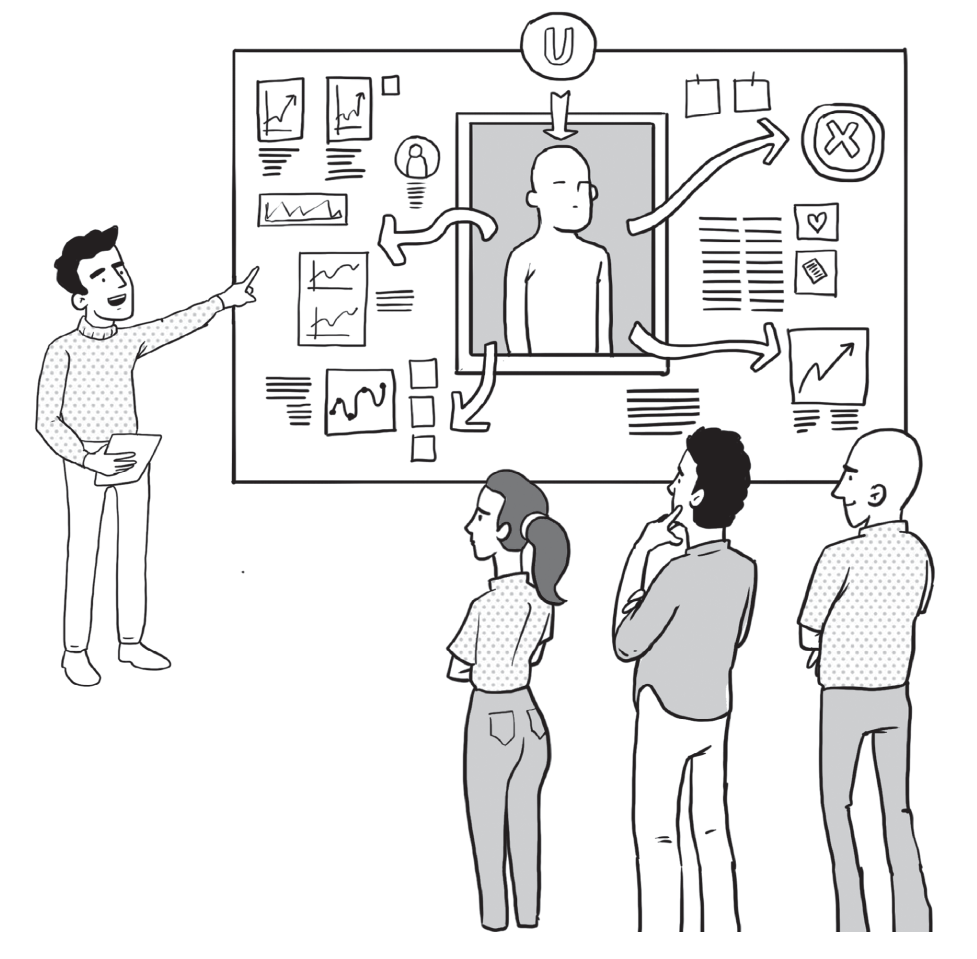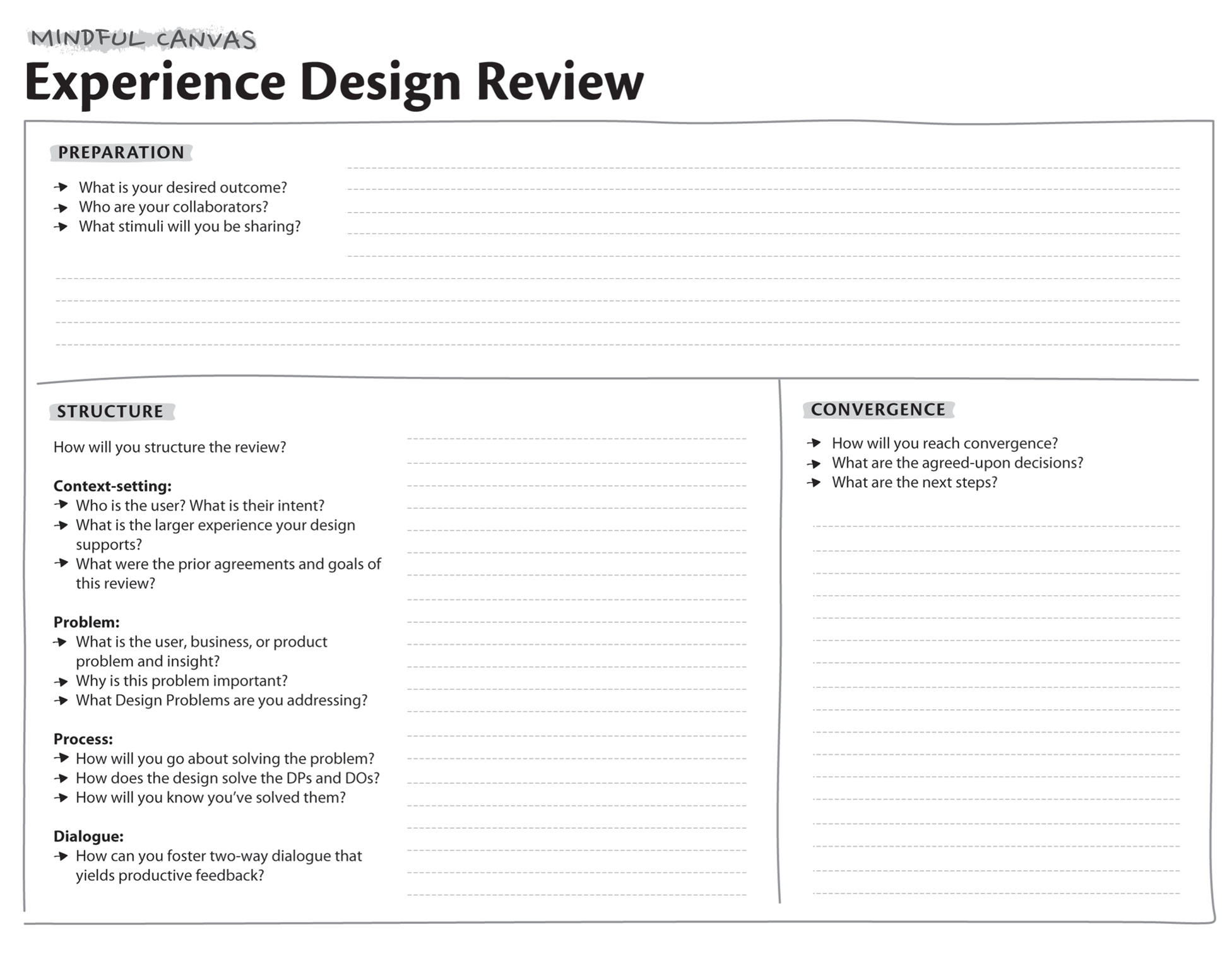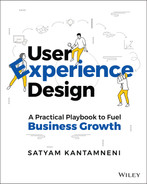CHAPTER 41
EXPERIENCE DESIGN REVIEW PLAY: How should an experience design review be run?
Poorly run experience design reviews cause unnecessary churn, missed deadlines, and the delivery of a subpar and ineffective solution. This play will empower practitioners and collaborators to get the most out of these reviews, thereby maximizing the effective usage of both time and resources.

Who Are the Key players in the Experience Design Review Play?
| ROLE | WHO’S INVOLVED | RESPONSIBILITIES |
|---|---|---|

DRIVER |
|
|

CONTRIBUTOR |
|
|

THE HOW
To run an effective experience design review, you need to be mindful of:
1. Doing the Right PREPARATION
Prepare for the upcoming experience design review by thinking through the following:
- Outcome: What is the ideal outcome of this review? What are you looking to achieve during this meeting? Your outcome will vary based on the problem as well as where this review falls on your product experience plan (Chapter 35: “Product Experience Planning Play”). Outcomes for an experience design review typically (although not exclusively) fall into two categories:
| CATEGORY | SAMPLE OUTCOMES |
|---|---|
| Alignment |
|
| Feedback |
|
Clearly define your outcome. It will serve as a target as you facilitate the meeting, bringing people back to your original intent if the discussion veers too far off course.
- Collaborators : Who are the collaborators you need to involve for this review? What role do they play? What questions do you anticipate them asking? Make sure all of the right and necessary parties are included and present to provide the feedback you are seeking. In addition, proactively anticipate curveball questions, both to avoid derailment and to ensure you can achieve your intended outcome.
Typical collaborators include (but are not limited to):
- Project sponsors, leaders;
- Product stakeholders;
- Internal collaborators;
- External collaborators;
- Experience practitioners;
- End users.
- Stimuli: Stimuli are the artifact(s) that you want your collaborators to react to during the experience design review. What stimuli will you be presenting? Pick the best stimuli that will elicit the feedback you need and help you achieve your intended outcome.
Typical stimuli include (but are not limited to):
- Design briefs;
- Experience ecosystems;
- Experience roadmaps;
- Storyboards;
- Vision‐types;
- Workflows;
- Wireframe variations;
- Visual explorations.
2. Deciding How to Best STRUCTURE Your Review
The traditional (ineffective) way of presenting design is for practitioners to show a specific artifact or screens to their collaborators and make it a free‐for‐all, share‐any‐feedback session.
The feedback, unfortunately, tends to be haphazard and “small‐design” focused:
“Why did you left align?” “Can you add this field on the screen?” “I don’t like this color.” “XYZ company does it another way,” “Can you move this button to the top?”
The reviews often are subjective, unstructured, and ultimately ineffective because collaborators don’t know how to react to the presentation.
In order to run an effective experience design review, follow this structure:
- First, set the context.
Address the reframed design problem (DP) or design opportunity (DO) that you have been solving (Chapter 34: “Design Problems and Opportunities Play”). Who is the user, and what outcomes are you looking to achieve? If you have already begun meeting, anchor on what was discussed in the previous session and provide an overview of what was agreed. Remember: If the collaborators themselves are not aligned on the user, their problems, and the outcomes, it actually creates unnecessary churn to hold a review. Foundational alignment must be addressed first.
- Second, share your approach and proposed solution/design and stimuli.
Walk your collaborators through your design process by discussing the following:
a. How did we go about solving the problem?
b. How does our design solve the DP or DO?
Cite any relevant metrics that you gathered during user research or that you plan to collect to prove that the root user, business, or product problem has been solved. Answer the question: How did we know we solved it?
- Third, start the dialogue.
An experience design review is not a one‐way presentation; it’s a two‐way dialogue between the designers and the collaborators. A back‐and‐forth can happen during any of the above steps for alignment, clarification, and feedback. Always ground your conversation in the user, the DPs and DOs, the metrics, and a solution to the problem, versus in a “pretty screen.” This will focus the dialogue on solving the experience problem at hand.
Let your collaborators know what feedback you’d like them to provide in today’s review. This helps ground everyone on the user and ensures the team delivers a great overall experience, even when the proposed design solution may just be a small piece of the larger experience puzzle.
If you are a participating collaborator, you have an important role in the review, pick one of the following questions or statements to kick‐start the dialogue:
a. Broad, high‐level questions in the initial discovery phrase.
b. Questions and statements that spur idea generation in the ideation and iteration phrase.
c. Statements of intent and clarifying questions to explore ways to achieve the intent during design review sessions.
This structured approach serves three purposes. First, collaborators are realigned on the bigger picture. Second, stating the underlying problem allows collaborators to attack the solution to the problem versus providing unguided or subjective feedback to the design. Lastly, this approach propels the conversation forward by allowing everyone to work together and identify a magical solution for the problem.
3. Guiding Stakeholders towards CONVERGENCE
The experience design review cannot be wholly effective without convergence. Convergence indicates reaching an agreement. It can take many forms, including:
- Aligning on key decisions made;
- Having clearly agreed‐upon action items, such us getting more data;
- Deciding on a path forward based on the best information available at a given time;
- Arriving at a single design solution that solves the user and business problem.
There are two helpful ways to facilitate convergence.
- Does this solution solve the intended user, business, or product problem? The best solution is not necessarily the prettiest one. Constantly refer back to this question, not only to drive convergence, but more importantly to ensure that you deliver an experience that meets the needs of your user.
- What do our experience design principles mandate? Your experience design principles are your organization’s benchmark about the experiences you plan to craft for your users. All experiences need to follow these principles. Use them as a guide to drive consensus. (see Chapter 42: Design Systems Play)
Examples of design principles include:
- Key flows should be accessible within one click;
- Data should be meaningful and actionable.
IN ORDER TO MAXIMIZE THE VALUE OF THIS PLAY
- Talk experiences, not user interface. When presenting early conceptual designs, be sure to focus on the entire experience, journey, and outcome, rather than on the small details on the screen. This will frame the discussion around the overarching experience instead of pigeonholing the team on tactical details.
- Conclude all presentations with key decisions made and next steps. Summarize any action items and set proper expectations for when your audience will see the next iteration of artifacts.
 RELATED PLAYS
RELATED PLAYS
- Chapter 35: “Product Experience Planning Play”
- Chapter 40: “Detailed Design Play”
